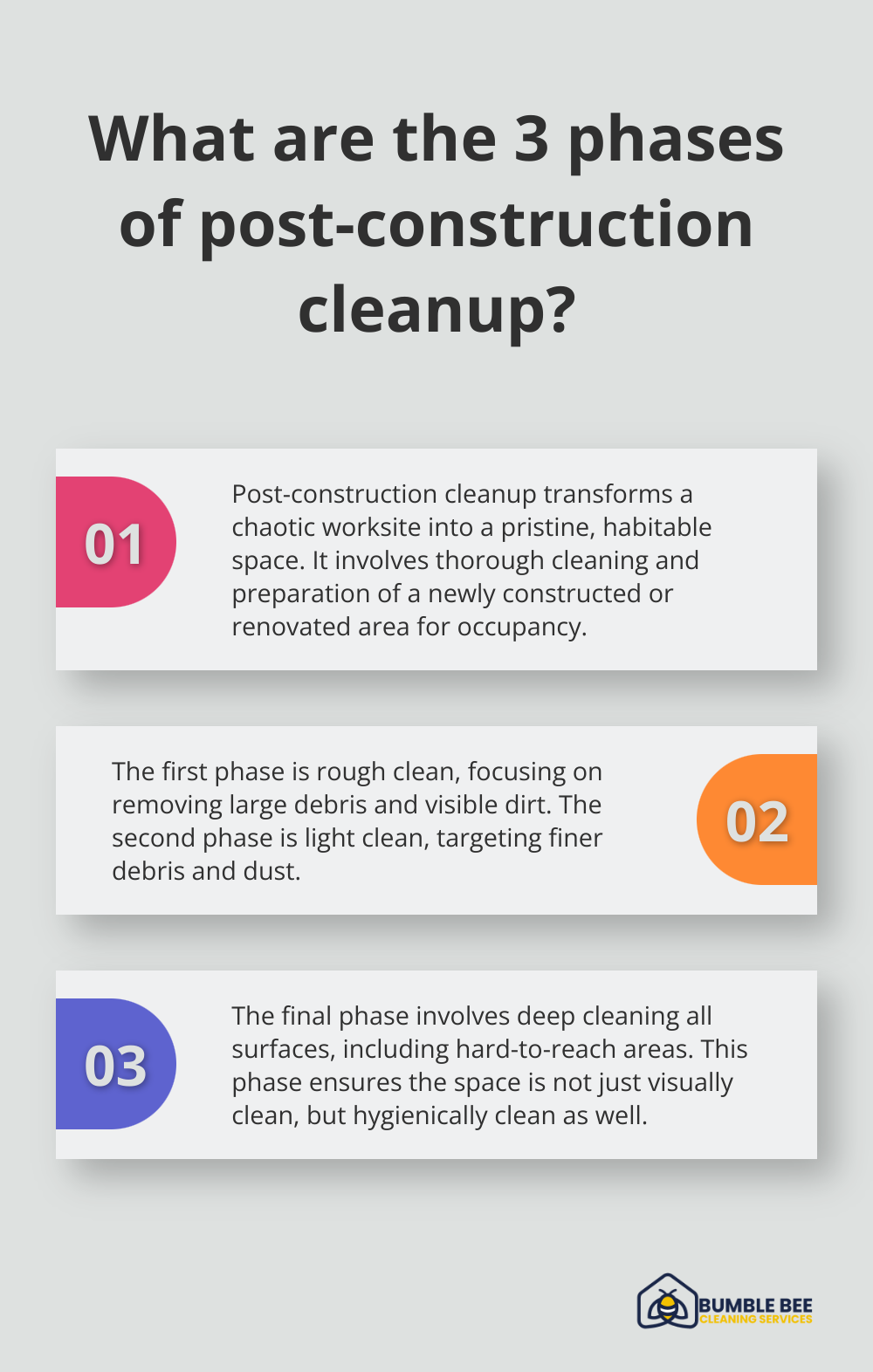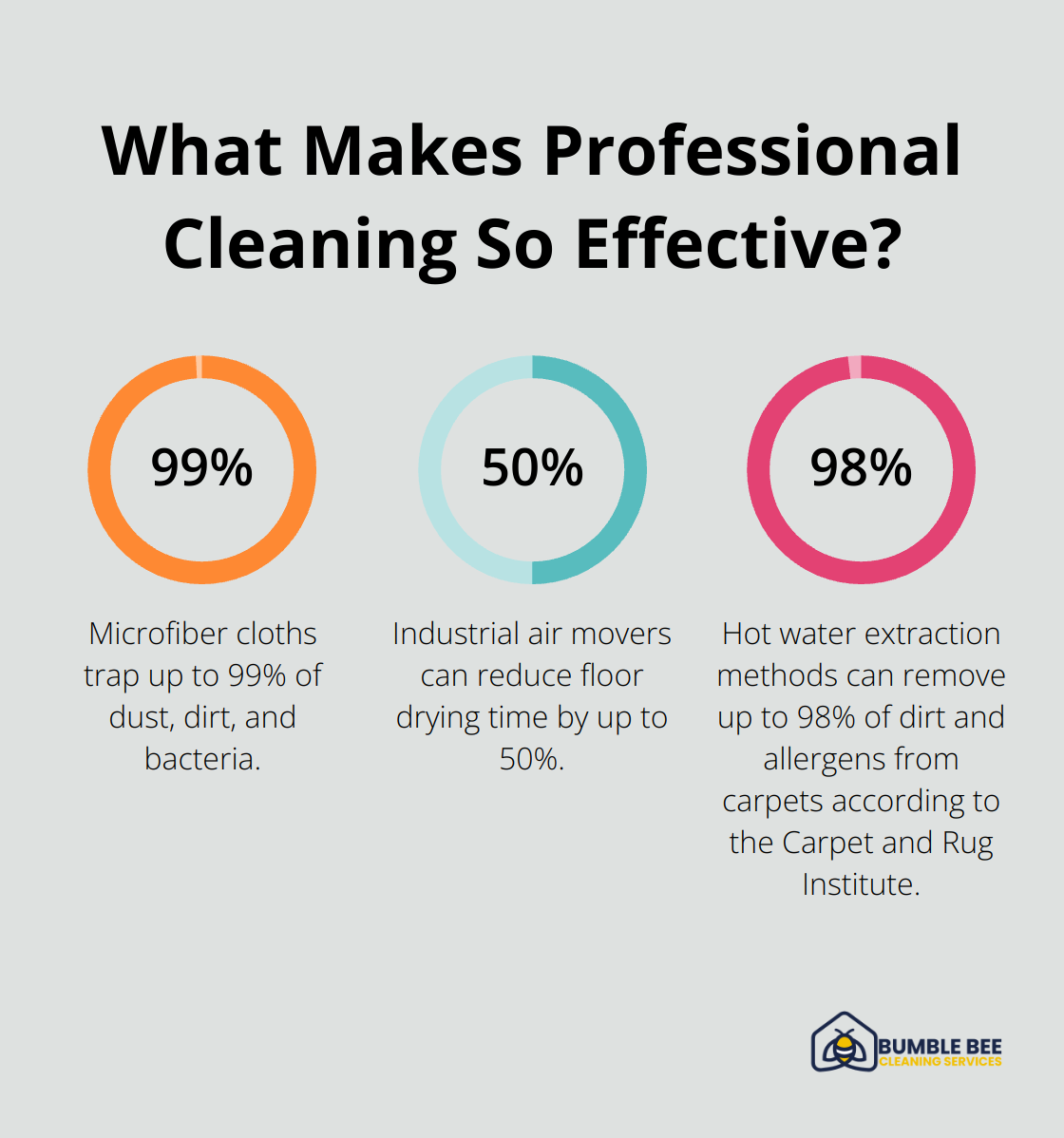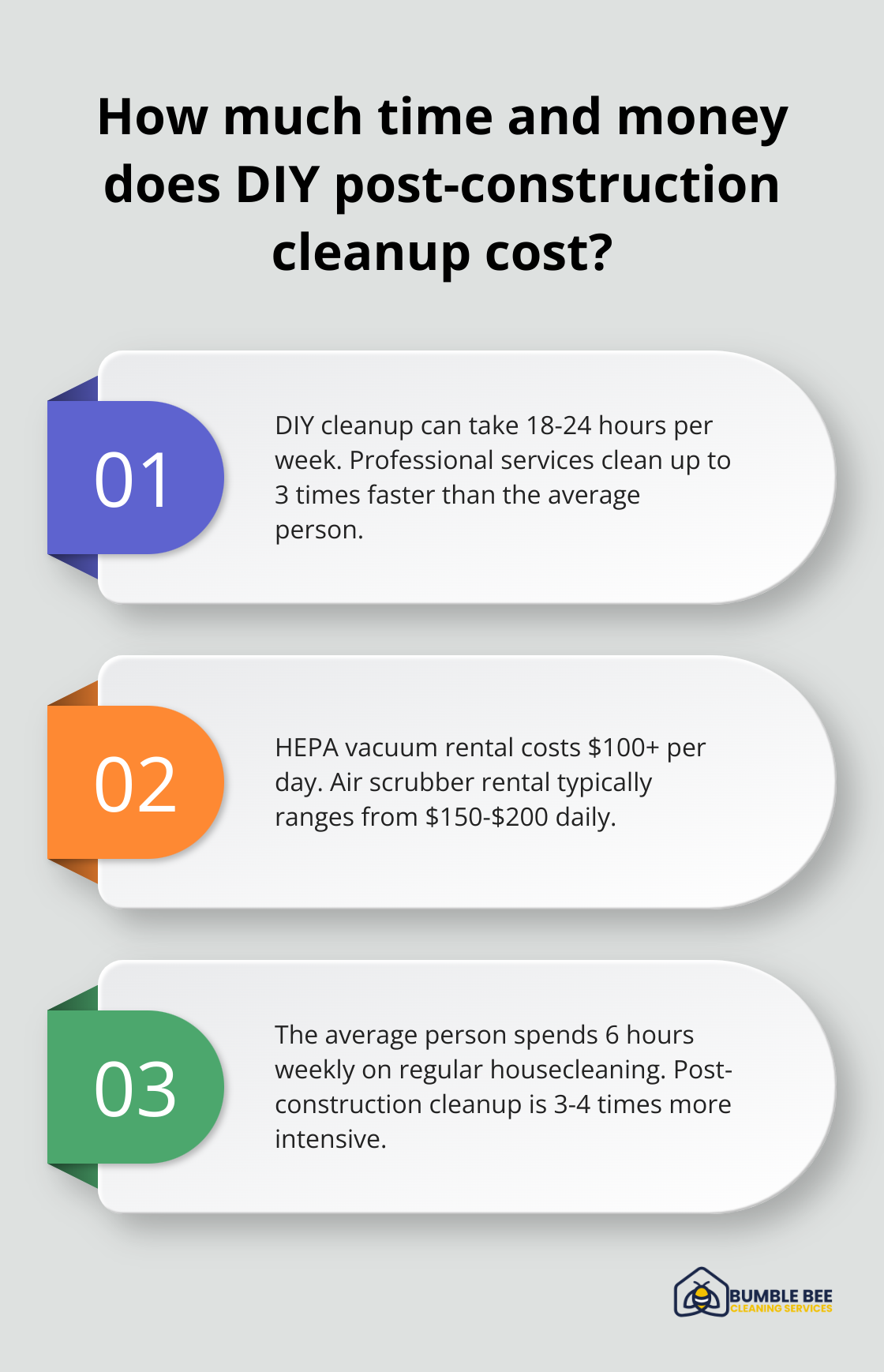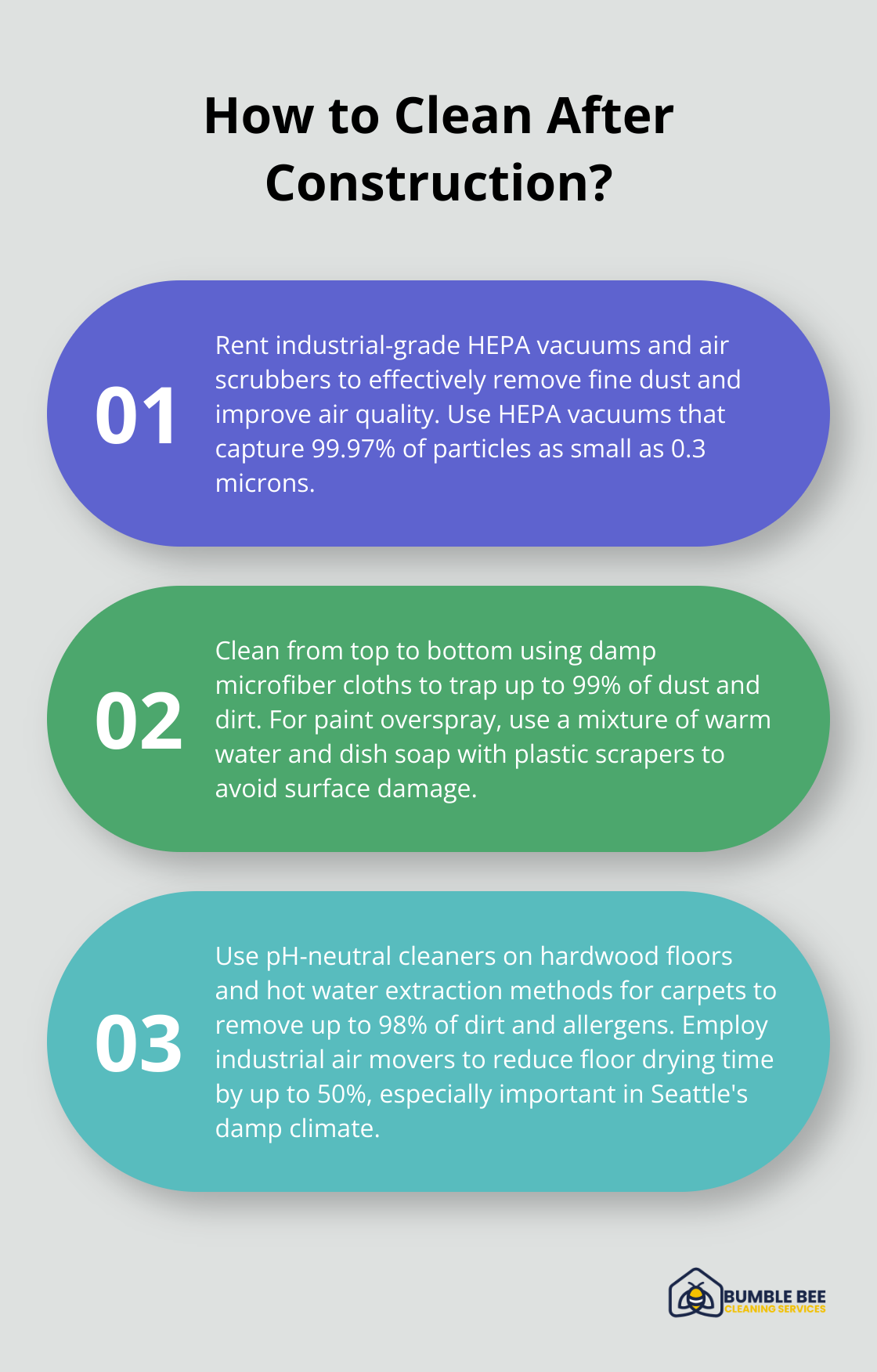Post-construction cleanup is a critical step in any building project, transforming a chaotic worksite into a pristine, habitable space. At Bumble Bee Cleaning Services, we’ve seen firsthand how proper cleanup can make or break the final impression of a construction project.
Dealing with construction debris, dust, and residual materials requires specialized knowledge and equipment. This guide will walk you through the essential steps of post-construction cleanup in Seattle, helping you understand the process and make informed decisions about tackling this crucial task.
What Is Post-Construction Cleanup?
Definition and Scope
Post-construction cleanup represents the final, essential phase of any building project. This process transforms a chaotic worksite into a pristine, habitable space. It involves the thorough cleaning and preparation of a newly constructed or renovated area for occupancy. The scope extends far beyond regular cleaning, requiring specialized knowledge, equipment, and techniques.

The primary objective of post-construction cleanup is to remove all debris, dust, and residual materials left behind after construction work. This encompasses everything from large pieces of scrap material to fine particles of dust that settle on every surface. The end goal is to create a clean, safe, and presentable environment ready for immediate use.
The Three Phases of Post-Construction Cleanup
Post-construction cleanup typically unfolds in three distinct phases:
- Rough Clean: This initial phase focuses on removing large debris, leftover materials, and visible dirt. Tasks often include sweeping floors, removing stickers from windows and appliances, and disposing of construction waste.
- Light Clean: The second phase targets finer debris and dust. This includes wiping down surfaces, vacuuming carpets, and cleaning windows. During this phase, the space starts to look noticeably cleaner.
- Final Clean: The last phase is the most detailed. It involves deep cleaning all surfaces, including hard-to-reach areas. This phase ensures that the space is not just visually clean, but hygienically clean as well.
Challenges in Post-Construction Cleaning
Post-construction cleanup presents unique challenges that require specialized solutions:
- Fine Dust Management: One of the biggest hurdles is dealing with fine dust that permeates every nook and cranny. This dust isn’t just unsightly; it can be harmful if inhaled and can damage new surfaces if not properly removed.
- Stubborn Material Removal: Removing materials like paint overspray, adhesive residues, and grout haze often requires specialized cleaning agents and techniques to avoid damaging underlying surfaces.
- Time Constraints: There’s often pressure to complete the cleanup quickly so that the space can be occupied. However, rushing the process can lead to overlooked areas or inadequate cleaning.
- Climate-Specific Issues: In Seattle, the rainy climate adds an extra layer of complexity. Mud and moisture can be tracked into construction sites (requiring additional cleaning efforts). Moreover, the humidity can make dust stick more stubbornly to surfaces, necessitating more vigorous cleaning methods.
To address these challenges effectively, professional cleaning services use HEPA filtration vacuums capable of capturing 99.97% of particles as small as 0.3 microns, ensuring thorough dust removal. They also employ eco-friendly cleaning solutions that effectively tackle tough residues without harming the environment or the building’s occupants.
Understanding these aspects of post-construction cleanup is vital for anyone overseeing a construction or renovation project. It ensures that the final step of the project – the cleanup – receives the attention it deserves. With this foundation laid, let’s explore the essential steps involved in a comprehensive post-construction cleanup process.
How to Execute a Flawless Post-Construction Cleanup
Removing Large Debris
The first step in post-construction cleanup involves the removal of large debris. This process requires the clearing of leftover construction materials, packaging, and other sizeable items. Proper sorting of these materials for recycling or disposal is essential, adhering to Seattle’s strict waste management regulations. The Seattle Department of Construction and Inspections reports that correct waste sorting can reduce landfill waste by up to 30%.
Tackling the Dust Problem
After large debris removal, the focus shifts to dust elimination. Construction dust poses not only aesthetic issues but also health hazards. Exposure to such particles can affect both your lungs and your heart. To combat this, industrial-grade HEPA vacuums (which capture 99.97% of particles as small as 0.3 microns) prove indispensable for improving indoor air quality post-construction.

For persistent dust on surfaces, damp wiping with microfiber cloths yields excellent results. These cloths trap up to 99% of dust, dirt, and bacteria, outperforming traditional cleaning methods. The cleaning process should always clean from top to bottom to prevent re-contamination of cleaned areas.
Deep Cleaning for Immaculate Results
The next critical phase involves deep cleaning of surfaces and fixtures. This includes addressing paint overspray, adhesive residues, and grout haze. A mixture of warm water and dish soap, combined with plastic scrapers, often removes paint overspray effectively without surface damage. Adhesive residues typically require specialized solvents, while a vinegar solution works best for grout haze on ceramic tiles.
Achieving Crystal Clear Windows
Window and glass cleaning significantly enhances a space’s appearance. The use of streak-free glass cleaners and microfiber cloths produces optimal results. For large commercial projects, professional-grade squeegees offer efficiency and effectiveness.
Restoring Floors to Prime Condition
Floor care and restoration often represent the final and most visible aspect of post-construction cleanup. Different flooring materials demand specific approaches. pH-neutral cleaners protect hardwood floors from damage. Carpets benefit from deep cleaning with hot water extraction methods, which (according to the Carpet and Rug Institute) can remove up to 98% of dirt and allergens.
Seattle’s damp climate necessitates thorough floor drying to prevent mold growth. Industrial air movers can reduce drying time by up to 50%.
Throughout the cleanup process, maintaining good ventilation remains key. Air scrubbers with activated carbon filters remove airborne particles and odors, significantly improving indoor air quality.
While DIY post-construction cleanup might seem appealing, the complexity and potential health risks make professional services a wise investment. Companies specializing in post-construction cleanup (such as Bumble Bee Cleaning Services) bring specialized equipment, eco-friendly products, and trained personnel to ensure a thorough and safe cleanup process.
The next chapter will explore the pros and cons of professional versus DIY post-construction cleanup, helping you make an informed decision for your project.
Professional vs. DIY Post-Construction Cleanup: Making the Right Choice
The True Cost of DIY Cleanup
DIY post-construction cleanup often appears cheaper at first glance. However, the true cost extends beyond just cleaning supplies. Time is a significant factor – what professionals accomplish in hours might take days for an inexperienced individual. The U.S. Bureau of Labor Statistics reports that the average person spends 6 hours per week on housecleaning. Post-construction cleanup is far more intensive, potentially consuming 3-4 times that amount.

Equipment rental is another often-overlooked expense. Industrial-grade HEPA vacuums, essential for thorough dust removal, can cost upwards of $100 per day to rent. Air scrubbers, another important tool, typically rent for $150-$200 per day. These costs quickly add up, especially for larger spaces or longer cleanup durations.
Health and Safety Risks
Post-construction environments pose unique health risks. The Occupational Safety and Health Administration (OSHA) identifies construction dust as a significant hazard, containing particles that can cause respiratory issues and other health problems. Without proper protective equipment and training, DIY cleaners expose themselves to these risks.
Professional cleaning services equip themselves with the necessary protective gear and follow strict safety protocols. They also carry insurance, protecting you from liability in case of accidents during the cleanup process.
The Value of Expertise
Professional post-construction cleanup services bring years of experience to the table. They understand the nuances of different materials and surfaces, knowing exactly which cleaning agents and techniques to use without causing damage. For instance, using the wrong cleaner on natural stone surfaces can lead to etching or discoloration – a costly mistake that professionals know how to avoid.
Moreover, professionals stay up-to-date with the latest cleaning technologies and eco-friendly products. The Environmental Protection Agency (EPA) reports that green cleaning products can reduce water pollution by up to 30% compared to traditional chemicals. Professional services often have access to these advanced, environmentally friendly solutions that might not be available to the general public.
Efficiency and Thoroughness
Time is often of the essence in post-construction scenarios. Property owners or businesses usually want to occupy the space as soon as possible. Professional cleaning services can complete the job much faster than a DIY approach. A study by the American Cleaning Institute found that professionals can clean up to 3 times faster than the average person, thanks to their experience and specialized equipment.
Thoroughness is another key factor. Professionals follow a systematic approach, ensuring no area is overlooked. They train to spot and address issues that an untrained eye might miss, such as paint overspray or adhesive residues that require special treatment.
Choosing the Right Service
When selecting a professional post-construction cleaning service, try to consider factors such as experience, certifications, and customer reviews. Look for companies (like Bumble Bee Cleaning Services) that offer specialized post-construction cleaning packages and use eco-friendly products. A reputable service will provide a detailed quote and explain their cleaning process, ensuring you understand exactly what you’re paying for.
Final Thoughts
Post-construction cleanup transforms a chaotic worksite into a pristine, safe, and habitable space. This process involves the removal of construction debris, dust management, and deep cleaning of surfaces. Professional post-construction cleaning services offer expertise, specialized equipment, and eco-friendly solutions that surpass DIY approaches in efficiency, thoroughness, and safety.
Bumble Bee Cleaning Services uses industrial-grade HEPA vacuums and eco-friendly products to deliver exceptional results in post-construction cleanup. Our team of professionals pays meticulous attention to detail, ensuring that every area is thoroughly cleaned and ready for immediate occupancy. We strive to complete projects in a timely manner while adhering to local regulations and addressing the unique challenges posed by Seattle’s climate.

A proper post-construction cleanup is the final touch that brings a construction project to life. It represents an investment in the health, safety, and aesthetic appeal of your space. Professional services can ensure that your newly constructed or renovated area shines in all its intended glory, ready to make a lasting impression.
